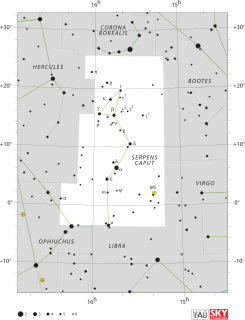
Serpens is a constellation in the northern celestial hemisphere. One of the 48 constellations listed by the 2nd-century astronomer Ptolemy, it remains one of the 88 modern constellations designated by the International Astronomical Union. It is unique among the modern constellations in being split into two non-contiguous parts, Serpens Caput to the west and Serpens Cauda to the east. Between these two halves lies the constellation of Ophiuchus, the "Serpent-Bearer". In figurative representations, the body of the serpent is represented as passing behind Ophiuchus between Mu Serpentis in Serpens Caput and Nu Serpentis in Serpens Cauda.

Selaginella is the sole genus of vascular plants in the family Selaginellaceae, the spikemosses or lesser clubmosses.
All stars but one can be associated with an IAU constellation. IAU constellations are areas of the sky. Although there are only 88 IAU constellations, the sky is actually divided into 89 irregularly shaped boxes as the constellation Serpens is split into two separate sections, Serpens Caput to the west and Serpens Cauda to the east.

Selaginella bryopteris (Devanagari:संजीवनी) is a lithophytic plant that is native to India. It is used medicinally in India and is one of the plants that is considered as a candidate to be the sanjeevani plant.

USS Serpens (AK-97) was a Crater-class cargo ship commissioned by the United States Navy for service in World War II. She was the first ship of the US Navy to have this name: she is named after Serpens, a constellation in the northern hemisphere. Serpens was crewed by United States Coast Guard personnel and was responsible for delivering troops, goods and equipment to locations in the Asiatic-Pacific Theater.

Selaginella lepidophylla is a species of desert plant in the spikemoss family (Selaginellaceae). Known as a "resurrection plant", S. lepidophylla is renowned for its ability to survive almost complete desiccation. During dry weather in its native habitat, its stems curl into a tight ball, uncurling only when exposed to moisture.

Selaginella apoda, commonly known as meadow spikemoss, is a perennial lycophyte native to much of the eastern United States and parts of northeastern Mexico. The life cycle is the shortest of the genus Selaginella, as well as one of the shortest among the lycophytes. Selaginella apoda is found primarily in damp soils in habitats such as swamps, wet fields, open woods and along stream banks. Selaginella apoda presents the potential for case studies involving the plant's adaptability to environmental toxins. A lowland plant, it has only been recorded at elevations below 100 meters. It is closely related to Selaginella eclipes and S. ludoviciana, with both of which it has been reported to form hybrids. This group is characterized by relatively flat strobili and large megasporophylls which occur in the same plane as the lateral leaves.

Selaginella selaginoides is a non-flowering plant of the spikemoss genus Selaginella with a wide distribution around the Northern Hemisphere. It resembles a moss in appearance but is a vascular plant belonging to the division Lycopodiophyta. It has a number of common names including lesser clubmoss, club spikemoss, northern spikemoss, low spikemoss and prickly mountain-moss. This plant has one close relative, Selaginella deflexa, native to Hawaii. These two plants form a small clade that is sister to all other Selaginella species.

Selaginella kraussiana is a species of vascular plant in the family Selaginellaceae. It is referred to by the common names Krauss' spikemoss, Krauss's clubmoss, or African clubmoss, and is found naturally in parts of Sub-Saharan Africa and in Macaronesia. It belongs to the very ancient lineage of plants known as the clubmosses.

Selaginella poulteri is a species of plant in the family Selaginellaceae.

Selaginella elmeri is a species of plant in the Selaginellaceae family.

Selaginella martensii, the variegated spikemoss or Martens's spike moss, is a lycophyte in the Selaginellaceae family. It is native to Mexico and Central America.

Selaginella uncinata, the blue spikemoss, peacock moss, peacock spikemoss, or spring blue spikemoss, is a species of plant in the Selaginellaceae family.

Sh2-54 is an extended bright nebula in the constellation of Serpens.

Selaginella denticulata, or Mediterranean clubmoss, is a non-flowering plant of the spikemoss genus Selaginella with a wide distribution around the Northern Hemisphere. Selaginella denticulata (L.) Spring., Formerly known as Lycopodium denticulatum L. and treintanudos is the common name in the Canaries.
Selaginella stellata, also recognized by its common name, starry spikemoss or starry spike-moss, is a species of spikemoss of the family Selaginellaceae. It is a type of lycopod that grows naturally in Mexico and Central American countries like Guatemala and Belize and can also be found in the state of Hawaii.

Selaginella tamariscina is a species of plant in the Selaginellaceae family, endemic to China, India, Japan, Korea, Philippines, Russia (Siberia), Taiwan, and northern Thailand. It is an evergreen perennial growing to 45cm in height.

Selaginella substipitata, the stalked spikemoss, is a species of plant in the Selaginellaceae family, endemic to Caribbean islands, Colombia, and Venezuela.

Selaginella willdenowii is a species of vascular plant in the Selaginellaceae family. It is a spikemoss known by the common names Willdenow's spikemoss and peacock fern due to its iridescent blue leaves. Like other Selaginallales, it is fern ally and not a true fern.
















